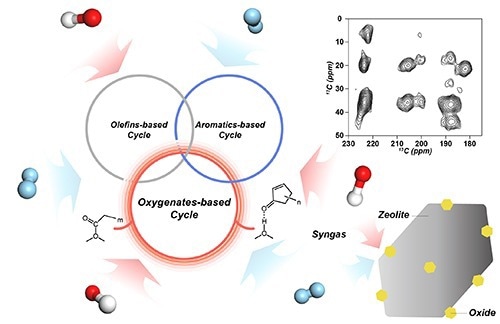Reviewed by Alex SmithJun 27 2022
A team of researchers led by Prof. Guangjin Hou and Prof. Xinhe Bao from the Chinese Academy of Sciences’ (CAS) Dalian Institute of Chemical Physics (DICP) has disclosed the oxygenate-based routes by solid-state Nuclear Magnetic Resonance (NMR) in syngas conversion over oxide–zeolite (OXZEO) bifunctional catalysts.
 Oxygenate-based routes regulate syngas conversion over OXZEO bifunctional catalysts. Image Credits: Yi Ji and Pan Gao
Oxygenate-based routes regulate syngas conversion over OXZEO bifunctional catalysts. Image Credits: Yi Ji and Pan Gao
This research was published on June 23rd, 2022, in Nature Catalysis.
In 2016, OXZEO catalysis was proposed by Prof. Xinhe Bao and Prof. Xiulian Pan from DICP. It offers a platform for the successful employment of coal and other resources of carbon. The reaction mechanism in OXZEO catalysis, however, is still unclear.
In this research, the scientists selected the syngas conversion instead of the ZnAlOx/H-ZSM-5 bifunctional catalyst as a model system to emphasize the mechanistic difference in the OXZEO-based syngas direct conversion. ZnAlOx is a classic metal oxide for the syngas to methanol process, whereas H-ZSM-5 is a classic zeolite for methanol to hydrocarbons (MTH) reaction.
Researchers employed the quasi-in-situ solid-state NMR (ssNMR)-Gas Chromatography (GC) analysis approach for disclosing the dynamic development of huge critical and/or transient intermediates—from the earliest initial induction period to the steady-state conversion in high-pressure flow-reaction settings. These intermediates include alkoxyls, multi-carbon carboxylates, methyl-cyclopentenyl carbocations, and acid-bounded methyl-cyclopentenones.
It was shown that oxygenate-based routes contributed to the aromatics and outlet olefins, where the feed, such as CO and H2, was also an active participant in these secondary reactions. The scientists also revealed that the main intermediates exist in multiple OXZEO catalysts in addition to the ZnAlOx/H-ZSM-5 catalyst, demonstrating the universality of oxygenate-based routes in OXZEO-based syngas conversion.
Our findings provide new insights into the reaction mechanism of syngas conversion on bifunctional catalysts, and may also help to better understand the mechanism of CO2 and biomass conversion.
Guangjin Hou, Professor, Dalian Institute of Chemical Physics, Chinese Academy of Sciences
This study was financially supported by the National Key R&D Programs of China, the National Natural Science Foundation of China, the Liaoning Revitalization Talents Programs, the China National Postdoctoral Programs for Innovative Talents, and the China Postdoctoral Science Foundation.
Journal Reference:
Ji, Y., et al (2022) Oxygenate-based routes regulate syngas conversion over oxide–zeolite bifunctional catalysts. Nature Catalysis. doi.org/10.1038/s41929-022-00806-2.